|
Library
Originally published in December 2001
issue of The Chinese Philatelist, official journal of the Philippine
Chinese Philatelic Club.
Introduction
Flowers Mini Stamps
Flag with National Symbols
Part I - April 1993
Part II - June
1993
Part III - Oct
1993
Part IV - 1994
Part V - 1995
Part VI - Nov 1995
Part VII - 1996
Part VIII - Feb
1996
Part IX - April
1996
Part X - Nov 1996
Part XI - 1997
Part XII -
Sampaguita
Part XIII - May
1997
Part XIV - South
Sea Pearls
Part XIVa - Dec
1997
Part XV -
Eagle
Part XVI - Eagle
High Value
Part XVII - June
1998
Part XVIII -
Kalabaw
|
THE PHILIPPINE FLAG
WITH NATIONAL SYMBOLS DEFINITIVES
By Dr. Ngo Tiong Tak
INTRODUCTION
There used to be several classes or types of
Philippine stamps. There were the regular issues or definitives,
commemorative and special stamps, semi-postal stamps, airmail
stamps, postage due stamps, special delivery stamps, official stamps
and even newspaper stamps. However, since the 1980's, the
Philippines have been issuing only 3 kinds of postage stamps:
definitives, commemoratives and special stamps.
Commemoratives and special stamps are usually larger
and more colorful than definitives. They are normally printed in
limited quantities and remain on sale for a short period of time.
These are the stamps that most collectors look for and are usually
the ones that attract new collectors to the hobby.
Definitives are smaller and are usually sold for many
years since they are normally sent to the press again and again
whenever additional quantities are needed. They are the workhorse
postage and are usually in different denominations that represent
all the basic postage charges plus others for odd rates and for
combinations to make up all existing rates. Generally, postal
administrators do not promote their definitive stamps to collectors,
presumably because they are small and less attractive in design
compared to commemoratives, which feature more interesting topics
and artistic designs. Definitives are really used day in and day out
to carry the mails, the actual purpose for which stamps were
created.
Most countries make their definitives plain and
small, in an effort to save on production costs, since large
quantities are needed. When the same design is used and printed
again and again for several years, chances are, interesting
varieties will be created. Variations in paper, gum, perforations
and the stamp design itself can often be found. This is one of the
reasons why many collectors and most serious philatelists are into
definitives that much, as they find them more challenging.
For Philippine Republic stamps, from the very first
series of definitives in 1947 up to 1973, every one of them were
printed abroad, usually in very large quantities to save on printing
and shipping costs. Usually, only one big print order is made for
each design and/or denomination. This is the reason why there are
hardly any varieties that can be found. Oftentimes, too many were
printed, so much so that many remain unsold and become obsolete
after every postage rate change. This is the reason why we encounter
so many overprints and surcharges and many collectors frown on such
stamps. Added to this is the fact that all of these imported
definitives were printed in one single color, so they are neither
all that attractive nor appealing to most collectors.
When we started printing most of our stamps locally
since 1973, the definitives were mostly in one single color too,
with a few having 2 colors. Most of them were printed in very large
quantities, oftentimes by installments and/or with several printings
and reprintings. However, even though many printings were made, the
same plate without any changes were used over and over again; which
is why no interesting varieties were created. The few collectible
varieties that can be found are different paper types only and these
seldom create much excitement nor offer much challenge, so our
definitives continue to be ignored by collectors.
Since most of our definitives were single color
printings, postal forgeries were discovered time and again.
Therefore, the authorities decided that multicolor printings should
be used for definitives even if this will increase the printing
costs. So starting with the Fiesta Islands '89 series of
definitives, all our stamps are multicolored. However, they are
still too easy to collect, as the only varieties we can find among
them are different papers, many of which can be distinguished more
readily only with the aid of an ultraviolet light.
PHILIPPINE FLOWERS MINI-STAMPS
The boring nature of our definitives took a dramatic
turn in 1991 though. Even though the demand for postage stamps
increased tremendously, the budget for stamp printing remained the
same; so, the management of the Post Office decided that our
definitives should be as small as reasonably acceptable. Instead of
100 stamps per sheet, they should print 200 pieces on the same size
stamp paper and come out with mini stamps. This way, they do not
have to alter the sizes and qualities of commemorative and special
stamps.
The new definitive series featuring Philippine
flowers on these mini-stamps proved to be the most interesting and
challenging up to that time. The stamps are colorful and the designs
attractive. There are even se-tenant blocks for the 4 basic rates
showing 4 different color morphs of the respective flower depicted.
Because of a postage rate hike in December 1991, almost every design
was revalued - creating more new stamps to collect. But that is not
the most exciting aspect yet. For the first time, there were major
varieties created when the printer decided to move the position of
the inscriptions and changed the size and/or position of the year
date "1991" on later printings in order to avoid unnecessary
spoilages. They unwittingly created redrawn designs of 11 stamps,
which were hardly noticed by collectors.
In 1992, there were again new varieties created when
the year date "1991" was changed to "1992" on all the new printings.
The reason for this is that both the Post Office and the printer,
Amstar, wanted to identify the new printings as such. There is this
policy of "first in, first out" and putting the new date will help
custodians and tellers decide which stamps to sell first. More
importantly, they need to know if the particular stamps are from the
new printing or will be part of the renegotiated quantities of the
earlier printings for which the Post Office is paying only 50% of
the original price. The printer is allowed an additional percentage
for spoilages when they were supplied with the security paper, so as
to be able to fill the ordered quantities completely. Most of the
time, there will be lots of good sheets left after the ordered
quantities have been delivered in full. Before, these over-runs were
destroyed together with spoiled stamps, but since 1989, the Post
Office has been "renegotiating" with the printer for these
additional quantities of good stamps and they pay only 50% of the
original price.
With the changed dates, the new printings became new
stamps, which most serious collectors need and want. Aside from
these, there are other new varieties of these new stamps for
specialists to search for. Since the Post Office became a
government corporation in June 1992, renamed to Philippine Postal
Corporation, the phosphorescent security mark PPS (for Philippine
Postal Service) was changed to PPC for all new printings. Most
Philippine collectors are unaware of these interesting varieties
because few are equipped with the ultraviolet lamp that is needed to
show the phosphorescent security marks.
The flowers definitives became one of the most
challenging series to pursue. From a face-different set of 42
values, it can become a 102-value set for specialists! For postal
historians, the challenge becomes even greater. Since all these
varieties were placed on sale only when that particular denomination
is needed, without any announcement, it is indeed a challenge to
search for covers showing the first day or early usages of the many
varieties such as the Type II's, "1992"-dated, and "PPC" security
marked reissues.
PHILIPPINE FLAG WITH NATIONAL SYMBOL DEFINITIVES
By 1993, our definitives got even more interesting
and challenging. Although the flower definitive series was quite
successful, there were complaints that the stamps were too small,
and that everyone was sick and tired of seeing the same flower
stamps on their everyday mail - that it was getting too monotonous
and boring already. So Philpost decided to come out with an entirely
new definitive series, even if the last series was in use for only
two years.
Late in 1992, Philpost experimented with a new stamp
size that is larger than the flower mini-stamps, but still much
smaller than the Fiesta Islands '89 definitives. They printed the
Mt. Pinatubo stamps in sheets of 200 stamps too, but the individual
stamps came out in just the "right size" - not too small and still,
almost as cheap to produce as the mini-stamps.
To address the complaints of seeing the same design
on everyday mail, Philpost came out with more varied designs, even
putting all 14 designs in the same sheet for local mail. By doing
this, there is very little chance that someone will be seeing the
same design over and over again on his mail. In fact, it is very
likely that many people will take a second look at the various
interesting designs and probably even keep the stamps and start
their own collections.
By putting the flag on every definitive, Philpost did
its share in helping our countrymen be more nationalistic and
patriotic by constantly reminding them to honor and respect our flag
each time they receive a letter. Letters franked with these
definitives immediately identify them as coming from the Philippines
because of the flag, and with all the various national symbols as
the main designs, this series became very educational, too; which is
why from the very start, Philpost has come out with a winner!
As it turned out, this definitive series became the
longest running and most challenging of them all also! This series
was in use for 6 years, issued in 18 parts, with a total number of
collectible single varieties that most collectors will want or need
at 132 different ones, including 10 in a souvenir sheet and 5
se-tenant blocks of 14, plus another 19 stamps for specialists to
search for! Everything is there - different papers, different year
dates, changes in color, type, size and/or position of inscriptions,
changes in phosphor security marks, different face values for the
same design, major to minor modifications to the main design,
presence or absence of the blue security band and even overprints!
All the Philippine flag with national symbols
definitives were printed by offset-litho in 4 colors by Amstar, in
sheets of 200 (20 x 10). They were all perforated 13 ½. The ones
printed in 1993 were all on local paper with "Republika ng
Pilipinas", "Kawanihan ng Koreo" and the seal of the Bureau of Posts
for watermarks. Starting with the 1994 reissues, all of these
definitives were printed on the imported, unwatermarked stamp paper
with embedded phosphorescent fibers. All of these definitives have
the greenish-yellow phosphorescent security marks of one kind or
another, except for the ten P1 stamps from the souvenir sheet issued
on June 12, 1993, wherein this phosphorescent marking was omitted.
PART I
(5 values dated 1993, issued on April 29, 1993)

Type
I
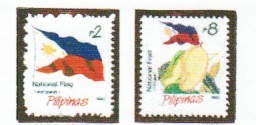
Type II
The 5 stamps to
kick off the new series were the P1, P2, P6, P7 and P8. The last 4
were for the basic rates: P2 for local mails, P6 for airmail letters
to Zone 1 (Asian countries), P7 for airmail letters to Zone 2
(Middle East, Australia, & New Zealand) and P8 for airmail letters
to Zone 3 (U.S.A. & Europe).
The original plan was to have the flag and
denomination on top and "PILIPINAS" at the bottom, but somehow, the
designers put the PILIPINAS on top also, so 4 of the 5 stamps ended
up with the national symbols covering part of our national flag. The
inscriptions were placed at the right side, overlapping the designs
and making them so difficult to read.
When the authorities finally decided to modify the
designs after receiving several complaints, the P1, P6 and P7 stamps
were completely printed already. Therefore, only the P2 and P8 were
redrawn. For the P2 Flag, aside from the PILIPINAS (which is now in
red instead of brown) being moved from the top to the bottom, the
black inscriptions were also repositioned. Instead of being centered
under the flag, the redrawn Type II stamps have the inscriptions
starting from the left side of the stamp. For the P8, the PILIPINAS
was changed from brown to red in color, and it was placed at the
bottom instead of the top. The black inscriptions were moved from
the right to the left, and they no longer overlap the design. Being
completely separated from the main design, the flag is now complete
and the inscriptions perfectly clear (naturally though, the main
design becomes much smaller). The redrawn type was used for all
later printings, including the 3 other designs from this Part I that
were included in the souvenir sheet of 10 with uniform denomination
of P1 that came out with the Part II stamps.
The P8 Type II came out earlier, on October 4, 1993.
The P2 Type II was not sold until February 10, 1994. Although a lot
of this Type II stamps were already printed by December 1993, all
were kept in the vaults because over 19,000,000 of the original
printing were delivered already.
All these 7 stamps from Part I are on the local,
watermarked paper. This local paper is not consistent in quality.
Some are whiter and/or smoother; some have whiter and/or thinner
gums. Under the ultraviolet light, the paper ranged from ordinary to
fluorescent to hibrite to reactions in between. These variations of
the local paper are true for all the rest of these definitives
printed in 1993.
The actual quantities printed for these 5 values are
very different from those announced in the bulletin. This is due to
the fact that there were additional "renegotiated" quantities, new
redrawn Type II stamps for the P2 and P8 (the renegotiated
quantities consist of only Type II stamps) and also that part of the
P2 reported in the bulletin was withheld and used for the printing
of the se-tenant block of 14 released in October, 1993.
|
DENOMINATIONS |
TYPE |
ORDERED QUANTITIES |
RENEGOTIATED QUANTITIES |
ACTUAL QUANTITIES |
|
P1.00 |
|
5,700,000 |
219,800 |
5,919,800 |
|
|
|
(114,500,000 in stamp bulletin) |
|
|
P2.00 |
Type I |
19,020,000 |
0 |
19,020,000 |
|
|
Type II |
65,477,600 |
3,390,000 |
68,867,600 |
|
P6.00 |
|
10,700,000 |
620,000 |
11,320,000 |
|
P7.00 |
|
13,600,000 |
800,000 |
14,400,000 |
|
|
|
24,500,000 |
|
|
|
P8.00 |
Type I |
9,740,000 |
0 |
9,740,000 |
|
|
Type II |
14,760,000 |
1,340,000 |
16,100,000 |
PART II (5 values dated 1993, plus a souvenir
sheet of 10 stamps issued on June 12, 1993)

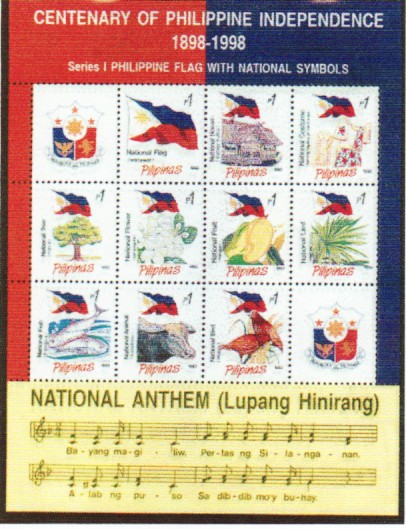
This second part, consisting of the 60s, P1.50, P3,
P5 and P10, was not sold until July 9. The reason for this long
delay is that two sets of proofs were rejected and new plates had to
be made each time.
The souvenir sheet was the first in an annual series
of 6 souvenir sheets. It contains all the 10 national symbols from
Parts I & II, plus 2 labels showing the seal of the Republic of the
Philippines. All 10 stamps in the souvenir sheet are denominated PI,
and all used redrawn designs with PILIPINAS at the bottom.
During printing, the souvenir sheet was arranged in
two rows of 4 on the press sheet, and was placed top-to-top,
resulting in 3 perforation types. The souvenir sheets on the bottom
row during perforating have one side margin imperforate and the
other side perforated. The 6 others on top of them are all
perforated through. Since they were top-to-top, one of these 2
bottom souvenir sheets will have the right margin imperforate while
the other will have the left margin imperforate. The other 6
souvenir sheets from each printed press sheet will have both right
and left margins perforated. Therefore, either of the 2 souvenir
sheets with one imperforate side is 6 times as scarce as the ones
perforated both sides.
The souvenir sheet was the first in a series to
publicize the centenary of the Philippine independence in 1998. All
5 succeeding souvenir sheets have similar headers (top margin with
inscriptions). The bottom margin of this first souvenir sheet
carries the first of 6 stanzas of the Philippine national anthem.
The succeeding stanzas of which, were found on the next annual
souvenir sheets, until it was completed in 1998.
The 10 stamps from this souvenir sheet are unique in
the sense that they do not have any phosphorescent security mark!
The "PPC" was printed only once, on the blue portion of the top
margin, near the center. All definitives since the Fiesta
Islands series 11 of June 1989 carry a phosphorescent security mark
of some kind, so single stamps from this souvenir sheet might be
mistaken for forgeries! All the 5 stamps and souvenir sheet are
still on the local watermarked paper.
The quantities printed were:
|
DENOMINATIONS |
ORDERED QUANTITIES |
RENEGOTIATED QUANTITIES |
ACTUAL QUANTITIES |
|
60s |
1,700,000 |
110,000 |
1,810,000 |
|
P1.50 |
12,500,000 |
390,000 |
12,890,000 |
|
P3.00 |
8,900,000 |
300,000 |
9,200,000 |
|
P5.00 |
5,700,000 |
220,000 |
5,920,000 |
|
P10.00 |
250,000 |
0 |
250,000 |
|
Souvenir Sheet |
25,000 |
0 |
25,000 |
PART III (se-tenant block of 14 x P2 dated 1993,
issued on October 28, 1993)
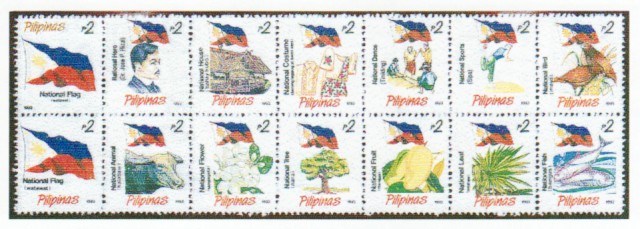
Type I Block of 14
Since almost 85,000,000 of the P2 Flag stamps (both
Typess I & II) were printed already, postal authorities were afraid
that many people will again complain that it is the only design they
ever see on local mails, even though it is unlikely that they will
say they are sick and tired of looking at our flag. So it was
decided that all the national symbols should be printed together in
one sheet. This way, chances that different designs will appear on
any person's mails are greater. Besides, by putting all the national
symbols together for the local mail rate stamps, Filipinos will
become familiar with all these symbols, as they have a good chance
of finding them in their mails. If one does not know that anahaw is
our national leaf and this design appears only on the P6 intended
for mails to Asian countries, he may never see this and learn about
it. Such a block of stamps can become a very good educational tool
in schools, too. The unprinted balance of 30,002,400 for the P2
stamp from the original order was therefore changed to this exciting
new format. Aside from the 10 previously issued symbols, the Stamp
Advisory Committee can come up with only 3 more. It would be
extremely difficult and/or confusing to fit 13 designs into a sheet
of 200 (20 x 10), so both types of the Flag stamps were needed.
Since the block will have 14 stamps (7 x 2), only 2 blocks can be
accommodated horizontally in the sheet of 200, which has 20 columns,
leaving 6 columns for an incomplete block of 12. To make the sheet
nicer, more orderly and more collectible, the 2 flag stamps on one
complete block of 14 were placed on the leftmost column and the ones
on the other complete block were placed on the rightmost column. The
incomplete block of 12 without the 2 Flag stamps in the center of
the sheet was thus relegated to be used for mailing purposes only.
Each sheet of 200 yields only 10 blocks of 14, 5 of each collectible
types. Type A has the 2 flag stamps at left while Type B will have
these 2 flag stamps at right.
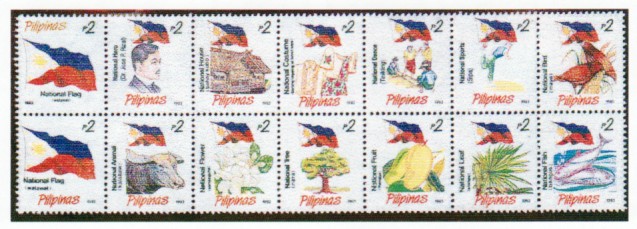
Type II Block of 14
This issue, still on the local
watermarked paper, became one of the largest se-tenant blocks
ever issued up to that time. What's more, there is a variety of
this block available. Later printings (Type 11) came with the
"1993" on the Flag stamp with brown "PILIPINAS" placed higher by
about 1 mm., so it is almost in line with the dates on the other
6 stamps in the row. The earlier printing (Type I) has this
"1993" lower, nearer the perforations at the bottom.
Unfortunately, even on the same sheet, the position of this
"1993" varies slightly; some will be exactly aligned with the
rest while others will be a bit higher or lower.
We have no record of when this
change was made, so we have no idea of exactly how many of each
type exists, but it appears that Type II started, at the latest,
shortly after 10,000,000 stamps were printed because sheet #
051633 is the Type II already. However, Type II still seems to
be scarcer and the one most collectors lack.
The two P2 Flag stamps from the
se-tenant block can be easily distinguished from those from the
regular single design sheets. For the Type I stamp, those from
the se-tenant block has the "PILIPINAS" and the P2 placed 1 mm.
lower, and the flag is also 12 mm. lower from PILIPINAS. There
is a bigger space between PILIPINAS and the flag. The "National
Flag (Watawat)" is 1/2 mm. higher and closer to the flag; the
"Watawat" is in smaller type, measuring only 4 2/3 mm. in length
instead of 6 1/2 mm.
For the Type II stamp, the one from
the se-tenant printing has the P2 placed 1/2 mm. higher and the
flag placed 1/2 mm. lower, so there is a 3-mm. space between the
P2 and the flag (instead of 2 mm. only). "1993" is placed 1 mm.
lower, making it appear at the level of the middle of "PILIPINAS"
instead of at the level of the top edge. "National Flag (Watawat)"
is almost 1 mm. higher, so it touches the rope of the flag.
For both Flag stamps from the Type
II se-tenant block printing, all the changes mentioned above
were maintained, except that all the black inscriptions are
thinner and much sharper now. Also, on the Flag stamp with the
brown PILIPINAS, "1993" is about 1 mm. higher. The distance from
its top edge to the end of the flag's rope is 2 2/3 - 3 mm.
instead of 4 mm. All the other 12 stamps in the Type II block
also exhibit the thinner and much sharper black inscriptions
when compared with the original Type I block.
As mentioned earlier, the quantity
of this block (both Types I & 11) represents the balance from
the original order of the P2 value. 30,002,400 were ordered and
with the renegotiated quantity of 1,290,000, a total of
31,292,400 stamps were delivered. That means there were 156,462
sheets of 200. Since each sheet yields only 10 blocks of 14,
there are only 1,564,620 blocks of 14, divided equally into
Types A & B.
PART IV (6 values dated 1994, first sold between
April 19 and December 1, 1994)

Starting with this issue, all the national symbols
definitives were printed on the imported unwatermarked paper with
embedded phosphorescent fibers.
This issue consists of only 6 values, the P1, P3, P5,
P6, P7 and P10. All have the new "1994" year date and the P6 and P7
are new redrawn Type 11 designs. However, since these reissues were
not considered new stamps, despite their obvious changes, no
official FDC nor cancel exist. In fact, no bulletin was prepared
because these reissues were pressed into service only when the need
for that particular denomination arises, so there are several
different first days of sale for these 6 stamps.
|
DENOMINATIONS |
FIRST DAY OF SALE |
ORDERED QUANTITIES |
RENEGOTIATED QUANTITIES |
ACTUAL QUANTITIES |
|
P1.00 |
May 3, 1994 |
5,000,000 |
440,000 |
5,440,000 |
|
P3.00 |
April 19, 1994 |
13,000,000 |
590,000 |
13,590,000 |
|
P5.00 |
April 19, 1994 |
7,500,000 |
470,000 |
7,970,000 |
|
P6.00 |
December 1, 1994 |
5,000,000 |
400,000 |
5,400,000 |
|
P7.00 |
July 6, 1994 |
11,000,000 |
259,200 |
11,259,200 |
|
P10.00 |
April 19, 1994 |
900,000 |
70,000 |
970,000 |
PART V (8 values dated 1995, first sold between
February 1 and May 5, 1995)
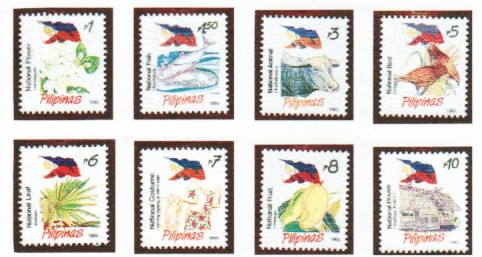
This issue consists of 8 values, P1, P1.50, P3, P5,
P6, P7, P8 and P10. All have the new date "1995", which is
positioned much lower than their counterparts in 1993 and 1994.
Again, these reissues were not considered new stamps, even if the
P8.00 is on unwatermarked paper for the first time. Neither official
FDC nor cancel exists also, and as expected, there are several
different first days of sale again.
|
DENOMINATIONS |
FIRST DAY OF SALE |
ORDERED QUANTITIES |
RENEGOTIATED QUANTITIES |
ACTUAL QUANTITIES |
|
P1.00 |
February 6, 1995 |
15,000,000 |
560,000 |
15,560,000 |
|
P1.50 |
February 6, 1995 |
16,000,000 |
960,000 |
16,960,000 |
|
P3.00 |
February 1, 1995 |
23,000,000 |
1,620,000 |
24,620,000 |
|
P5.00 |
February 1, 1995 |
12,000,000 |
580,000 |
12,580,000 |
|
P6.00 |
April 3, 1995 |
14,000,000 |
370,000 |
14,370,000 |
|
P7.00 |
May 5, 1995 |
10,000,000 |
359,600 |
10,359,600 |
|
P8.00 |
March 14, 1995 |
18,000,000 |
900,000 |
18,900,000 |
|
P10.00 |
April 3, 1995 |
2,000,000 |
140,000 |
2,140,000 |
All the P3.00 national symbols definitives (including
those dated 1993, 1994 and 1995) were withdrawn from sale on April
3, 1995 and all post office stocks recalled starting June 20, 1995
under an all office message No. 95-4513 dated May 31, 1995 after
discovery of alleged postal forgeries, which no collector nor dealer
has ever seen or studied, and which probably are just washed and/or
reused stamps only. Between June 20 and July 3, recalled stamps
totaled 3,174,420, which were added to the balance of 14,000,000
still in the vaults. Almost all of these stamps were dated "1995".
These withdrawn stamps were subsequently overprinted with the
Philippine Centennial Commission logo and reissued in 1998.
PART VI (se-tenant block of 14 x P2 dated 1995, with
blue security band and new national bird design, issued on November
2, 1995)
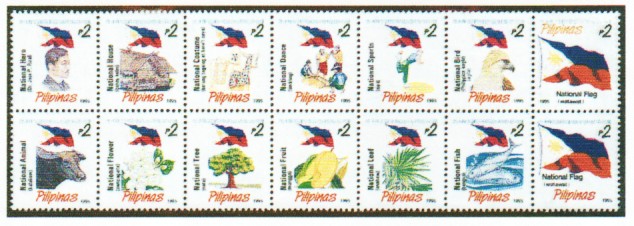
This is basically a reissue of the Part III block,
except that it is now on unwatermarked paper and each stamp is dated
"1995". All the stamps were redrawn to include the blue security
band that appears at the top of the designs, therefore, the main
designs became smaller. The size and position of the inscriptions at
left and the year were changed on most stamps too.
The blue security band is supposed to be an
additional security feature because somebody believes that such a
band will make the stamps more difficult to fake! Actually, it is
just a band composed of short lines and strokes with the word
"Philippine Postal Corporation" hidden within it, and you need a
good magnifying glass to see what you already know is there.
By this time, our national bird had been changed from
the Maya to the Philippine eagle. Therefore, the design for the
national bird on this block was changed.
n the 1995 stamp program, there were 9 values in
the definitive series to cover all the commonly used rates.
However, only 8 national symbols definitives were actually re-issued with the
"1995" year date by May. The P2 reissue was held in abeyance as
there were so many P2 commemorative and special stamps in the
vaults. Most issues of 1994 were in P2 denominations and the
printing quantities for 1993 issues were mostly 600,000 each - which
were simply too much! Another reason for the delay in the printing
of the P2 was that there was a planned postage rate hike, which was
expected to first affect the local rate only. The rate hike was
initially planned for March 1995, and then it was postponed to July,
then October until finally, Philpost felt it could no longer
subsidize the local rate and was bent on doubling the local rate to
P4 starting November 1. For several years, Philpost had been
subsidizing the local mail. Even when the rate was still P2, it
costs more to process a letter than what the mailing public was
paying. But the costs kept increasing, until it was costing P3.72 to
process one local letter. However, there was a requirement that
petitions for such local postage rate hikes should be published in
newspapers of general circulation for at least 3 times within 3
weeks before these can be taken up during public bearings at the
Department of Transportation and Communications (DOTC). In this
instance, it took several of such hearings. By October, the P2
stamps were about to be depleted, so it was decided that out of the
60,000,000 pieces allocated for the P2 definitives in the 1995
program, they had to print 50% right away, as Philpost was not sure
when the rate hike could finally be implemented. So on November 2,
the P2 Flag reissue was placed on sale. This quantity of 30,000,
000 were printed as an emergency measure since Philpost expected to
raise the rate to P4 by December 1, 1995. Therefore, the balance of
30,000,000 was ordered with the new P4 denomination.
Unfortunately, the public hearings at the DOTC took
much longer than anticipated, so the rate hike could not be
implemented as planned. When the approval was finally given, there
was another requirement that an announcement for this should be
published in major newspapers at least twice, 2 weeks prior to its
implementation. So the earliest date it could take effect was
January 8, 1996.
The actual quantities printed for this P2 reissue was
30,000,000 ordered plus 1,341,800 renegotiated on October 28, 1996
for a total of 31,341,800. Just like with the original block of 14
issued in 1993, each sheet of 200 yields only 10 complete blocks of
14 (5 Type A and 5 Type B). So only 1,567,090 blocks of 14 exist.
PART VII (se-tenant block of 14 x P4 dated 1995,
with blue security band and blue PILIPINAS, issued on January 8, 1996)
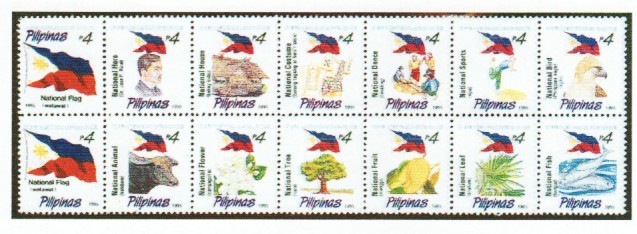
As mentioned earlier, this revalued block was ordered
when Philpost thought they could implement the rate hike by December
1, 1995 or very soon thereafter. The 30,000,000 pieces ordered were
actually one half of the approved quantity for the P2 denomination
in the 1995 program. They were printed in early December of 1995, to
enable Philpost to distribute them to all regions. The custodians
were instructed not to start selling them until the planned date of
issue, which is to be the day when the rate will become P4.
Unfortunately, some were sold even before Christmas - once again
showing that many regional custodians do not follow instructions.
Since these stamps were to be paid for with funds
from the 1995 stamp printing budget and were actually printed in
late 1995, all were dated "1995", even if they were officially sold
only starting January 8, 1996.
The actual quantities printed were 30,000,000 ordered
plus 836,800 renegotiated on January 7, 1997, for a total of
30,836,800. Therefore, only 1,541,840 complete blocks of 14 exist.
PART VIII (4 values & se-tenant block of 14 x P4,
all dated "1996", with blue security band and blue PILIPINAS; with
new design for both national animal stamps, scheduled for issuance
on February 12, 1996)

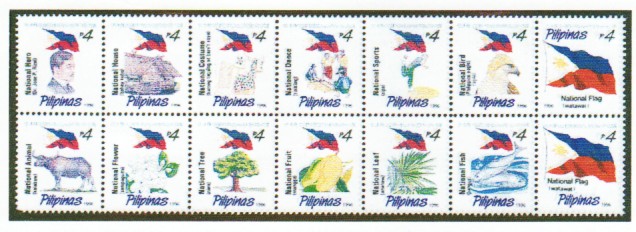
When the 1996 stamp program was prepared and later
approved, the following values and quantities in the definitive
series were included:
|
DENOMINATIONS |
ORDERED QUANTITIES |
DENOMINATIONS |
ORDERED QUANTITIES |
|
P1 |
16,000,000 |
P6.00 |
3,000,000 |
|
P1.50 |
16,000,000 |
P7.00 |
7,000,000 |
|
P3.00 |
17,000,000 |
P8.00 |
15,000,000 |
|
P4.00 |
70,000,000 |
P10.00 |
2,300,000 |
|
P5.00 |
20,000,000 |
|
|
Since all the other postage rates were also expected
to increase soon, with a tentative date of February 1, 1996 (which
was later changed to March 1, then to April, July and finally
postponed indefinitely), most values were expected to become
obsolete once the rates change, so only the P4 were needed in
quantity. However, since stocks of the low values were already
depleted, there was an immediate need to print also the PI, P1.50,
P3 and P5 stamps. In order to avoid printing values that may soon
become obsolete, only 3,000,000 of each of these 4 values were
ordered initially, with the balance to be revalued to future new
rates. This is the reason why the quantities reported for these 4
values in the philatelic bulletin are only 3,000,000 each. Since the
planned rate hike did not push through until 1998, later quarterly
orders changed the actual quantities ordered. For the P1 and P1.50,
they were less than in the program, but for the P5, it was more.
Before the new order was placed, it was pointed out
that with the reissue of new P3 stamps in the old design, the
probability of forgeries resurfacing again will be great. It should
be recalled that allegedly dangerous postal forgeries of the P3
Kalabaw stamp were discovered in 1995, so that all unsold stamps
were withdrawn from sale and all stocks recalled and returned to the
vaults. To prevent this from happening, it was decided that the
design for the Kalabaw stamp should be changed. So instead of only
the head, the whole animal will be depicted. Since the national
animal was included in the se-tenant block of 14 x P4, it was only
appropriate to change that particular design, too.
Because these 5 values scheduled for issuance on
February 12, 1996 were ordered and printed in 1996, to be paid for
with funds from the approved stamp printing budget for 1996, they
naturally carry the new "1996" year date.
The 4 single stamps are actually new stamps even if
we ignore the year change, since the designs now include the blue
security band and the P3 and P5 are entirely new designs. The P4
block as a whole is new also because the Kalabaw design is new.
The P1, P1.50 and P5 were needed very badly, so the
printer was requested to rush the printing of these 3 stamps first.
The P4 block was not made available for sale until February 19, and
the P3 was not delivered until March 1. The reason for the long
delay in the delivery of the P3 stamps was due to the fact that its
printing was actually cancelled when the Chief of Postage Division
said that there was no longer any need for a P3 stamp since the
local rate had increased to P4. The P3 was used mainly for special
delivery letters (P2 + P 1 additional fee), and now that it rose to
P5 (P4 + P 1), there was naturally no more need for the P3.
Unfortunately, this was not conveyed to the Philatelic Division or
the printer on time, so the P3 value appeared in the philatelic
bulletin that was distributed a few days after the issuance on
February 12. After some consultation, it was finally decided on
February 21, 1996 that the printing of the P3 stamp should proceed
to avoid confusion. Since this stamp has an entirely new design, it
can still be used in combination with other stamps for other rates.
|
DENOMINATIONS |
FIRST DAY OF SALE |
ORDERED QUANTITIES |
RENEGOTIATED QUANTITIES |
ACTUAL QUANTITIES |
|
P1.00 |
February 12, 1996 |
12,000,000 |
555,600 |
12,555,600 |
|
P1.50 |
February 13, 1996 |
8,000,000 |
449,600 |
8,449,600 |
|
P3.00 |
March 1, 1996 |
17,000,000 |
207,000 |
17,207,000 |
|
|
|
|
|
|
|
P4.00 |
February 19, 1996 |
70,000,000 |
2,656,600 |
72,656,600 |
|
|
|
|
(3,632,830 complete blocks of 14 only) |
|
P5.00 |
February 12, 1996 |
23,000,000 |
301,000 |
23,301,000 |
By early 1997, the following designs from the 2 types
of se-tenant blocks of 14 were ordered removed because of discovery
of alleged forgeries: Flag, flower, animal and dance.
On August 25, 1997, then PMG Intia circulated an all
office message No. 97-39P recalling all P4 definitive stamps
featuring the national symbols. Effective August 31, 1997, selling
of these stamps shall immediately be stopped and letters affixed
with said stamps refused. Postmasters must return to their
respective regional stamp custodians all stocks of these definitives
on or before August 31, 1997. The regional stamp
custodians shall return all stocks of the recalled stamps to the
Postage Division, Central Office, not later than September 30,
1997.
Mailers with unused stamps after August 31, 1997 can
return them by exchanging them for another definitive issue of
similar value at the post office starting September 1 to 15 only.
However, the redemption period was later extended by another month.
On August 26, 1997, a memorandum was circulated to
all regional directors and regional stamp custodians instructing
them to distribute to all post offices the new P4 "South Sea Pearl"
definitive issued on June 10, 1997, adding that the said stamp was
issued purposely as replacement for the P4 definitive stamps
featuring the 13 national symbols.
PART IX (3
values dated "1996"; with blue security band & blue PILIPINAS,
scheduled for issuance on April 19, 1996)
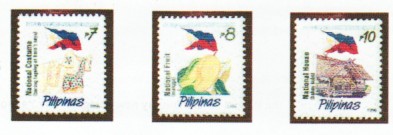
This
issue consists of the P7, P8 and P10 stamps. They were also
redrawn to include the blue security band, so the main designs
are naturally smaller. The quantities printed for the P7 is over
and the P8 is less than the quantities approved in the 1996
program.
For
the P7, after the 7,000,000 were completely delivered, there was
an additional order during the last quarter for another
3,000,000. Adding the renegotiated quantities of 184,600 for the
original order and 141,600 for the additional order, the final
total becomes 10,326,200.
For
the P8, originally, the order totals only 12,000,000 but an
additional order of 1,000,000 were made in the last quarter,
which were delivered only on January 29, 1997. Adding the
renegotiated quantities of 284,600 from the original printing
and 74,800 from the additional printing, the final total comes
to 13,359,400.
For
the P10, the programmed 2,300,000 were ordered, and with the
renegotiated quantity of 178,600, the total became 2,478,600.
All
of these 3 reissues were sold starting May 7, 1996 only,
although the first day cancel still reads April 19, 1996.
PART X (P6 dated "1996"; with blue security band
& blue PILIPINAS, issued on November 21, 1996)
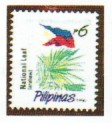
This
single stamp was redrawn also to include the blue security band,
so the basic design (flag & leaf) is smaller than on the earlier
1994 and 1995 reissues. This completes the set of single designs
dated "1996" which totals 8 values from the 3 issuances.
The
quantity printed was the programmed 3,000,000; but with the
additional renegotiated quantity, the total comes to 3,116,800.
PART XI (6 values dated "1997" ; without the blue security
band, but with phosphorescent security band instead; first sold
between February 26 and March 10, 1997)

The
"1997" dated reissues are the most complicated series since
there are actually 3 separate groups: without blue security
band, with blue security band and with new style phosphorescent
security mark.
For
the first group, which has the blue security band at the top
removed, the P1, P5, P7, P8 and P10 are similar in design to the
"1996" reissues except for the "1997" date. Strangely though,
the P6 has the bigger design of the "1994" and "1995" reissues.
All 6 stamps are without the blue security band that is printed
on all stamps (definitives, commemoratives and special stamps
and even on stamps in souvenir sheets) since the Catholic
Bishops Conference of the Philippines stamp of July 22, 1995.
However, this security band is not really totally omitted. It
just became part of the phosphorescent security mark, which can
be seen only with the aid of an ultraviolet light. It appears as
an additional line (lower than where the printed blue band
should be) above the normal "PPC" which is printed sideways,
reading up. The reason for this change is that many collectors
complain that the presence of this blue band often makes the
stamp design look off-centered even if it was perforated
perfectly. Everyone knows that such a band will not make it more
difficult for criminals to create forgeries. If they can copy
the multicolored designs, why would such a simple band make
things more difficult for them? So the officials decided to just
incorporate this security band to the usual phosphorescent
security marking, which I think is a wiser decision. Starting
with the first 1997 issue, the Hong Kong 1997 Exhibition
souvenir sheets, this band was removed from all commemorative
and special stamps.
However, not long afterwards, the authorities decided that the
commemoratives and special stamps could do without this printed
blue band, but not the definitives! Therefore, with the revalued
P2 sampaguita definitive issued on April 15, 1997, the printed
blue security band was put back on all definitives, including
newer printings of the 5 other values in the "1997" reissues. Up
to this day, all definitives carry this printed blue security
band, except for the P5 Roxas-Quirino definitive pair issued on
February 6, 2000.It was gathered that the absence of the
security band on this pair of stamps was a mistake that was not
caught in time.
Though these reissues without the printed blue band with blue
PILIPINAS are so different from previous issues, they were again
treated as "reprints" for postage use only, so no official first
day cover or cancel exists. However, a bulletin without
illustrations was later distributed, announcing the release of
these reissues, plus the P3, which actually carry the printed
blue band already.
By
the second quarter, new orders created the second group of
"1997" reissues, which include the printed blue band again.
These later printings included a P3 stamp but there was no P1
stamp because the latter was revalued to P2 and issued
officially with a first day cover and bulletin. When Amstar
delivered the accumulated renegotiated quantities, those with
and those without the blue bands were counted together, so the
exact quantities of each type is unknown. The best we can do is
come up with estimates; using the respective quantities printed
and pro-rating the total renegotiated quantities.
Since
these reissues were again sold only when the need for that
particular value arises, there are several first days of sale.
|
DENOMINATIONS |
FIRST DAY OF SALE |
ORDERED QUANTITIES |
RENEGOTIATED QUANTITIES |
ACTUAL QUANTITIES |
|
P1.00 |
February 27, 1997 |
3,000,000 |
30,000 |
3,030,000 |
|
P5.00 |
February 26, 1997 |
6,000,000 |
(230,000) * |
(6,230,000) * |
|
P6.00 |
March 10, 1997 |
4,000,000 |
(190,000) * |
(4,190,000) * |
|
P7.00 |
March 7, 1997 |
5,000,000 |
(176,000) * |
(5,176,000) * |
|
P8.00 |
March 6, 1997 |
5,000,000 |
(154,000) * |
(5,154,000) * |
|
P10.00 |
February 27, 1997 |
600,000 |
(35,000) * |
(635,000) * |
(*Estimates
as of time of writing)
PART
XII (Sampaguita design revalued to P2 dated "1997", with blue
security band & blue PILIPINAS, issued on April 15, 1997)
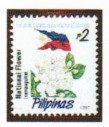
The P1 Sampaguita stamp was revalued to P2 to meet operational needs.
It is quite similar to the P2 stamps from the se-tenant block
issued on November 2, 1995; but upon closer inspection, aside
from the new "1997" date and blue PILIPINAS (instead of red),
more of the main design is shown on the new printing. There are
more green leaves at the left and bottom, the black inscriptions
at left is farther from the main design and is closer to the
left perforations.
The
quantity ordered were 3,000,000, but there was a renegotiated
quantity of 129,000, making the total 3,129,000.
PART
XIII (6 values dated "1997", with blue security band and blue
PILIPINAS, first sold between April 18 and May 8, 1997)

Except for the P3 which was not included in the first quarter
order, the other 5 values (P5, P6, P7, P8 and P10) were
additional orders made during the 2nd and 3rd quarters, and all
6 values now have the blue security band at top. The P6 changed
back to the smaller design used in the "1996" reissue. With the
blue security band back, the phosphorescent security marking
reverted to the original with "PPC" only.
By
the 4th quarter, a new style phosphorescent security mark was
used. This consists of 3 parts: Philpost logo in the center, an
upright "PPC" at the bottom and a vertical line identical to the
blue security band at top. On many stamps, this band is very
difficult to see or almost absent. Since this new phosphor
marking can be seen only with the aid of the UV light, very few
collectors are aware of this. But to specialists, these are
entirely new varieties. So I will separate these and treat them
as a subtype of Part XIV, as the last group of the "1997"- dated
definitives.
I
will also separate the quantities for each variety. Of course,
just like the first quarter reissues without the blue band, the
quantities are estimates only since the printer had mixed both
types when they delivered the additional renegotiated
quantities.
These
reissues were again considered as "reprints" for postage use.
Neither official FDC nor bulletin exists. And as usual, there
are different first days of sale.
|
DENOMINATIONS |
FIRST DAY OF SALE |
ORDERED QUANTITIES |
RENEGOTIATED QUANTITIES |
ACTUAL QUANTITIES |
|
P3.00 |
April 18, 1997 |
2,000,000 |
73,000 |
2,073,000 |
|
P5.00 |
April 29, 1997 |
11,500,000 |
(443,000) * |
(11,943,000) * |
|
P6.00 |
April 18, 1997 |
6,000,000 |
(283,000) * |
(6,283,000) * |
|
P7.00 |
May 8, 1997 |
10,000,000 |
(352,000) * |
(10,352,000) * |
|
P8.00 |
May 8, 1997 |
10,000,000 |
(308,000) * |
(10,308,000) * |
|
P10.00 |
April 22, 1997 |
4,400,000 |
(256, 400) * |
(4,656,400) * |
(*Estimates
as of time of writing)
PART XIV (P4 new symbol (national gem), issued
on June 10, 1997)

Since
there was no new P4 stamp reissued with the "1997" date yet, the
stock of this local rate stamp was almost depleted when this new
design was being prepared. This stamp features an entirely new
national symbol, the South Sea Pearl, which was then recently
declared as the national gem. At about this time, alleged
forgeries of several designs in the P4 se-tenant block were
discovered. It was then decided that reissuing the se-tenant
block with "1997" date with this new symbol to replace the Type
I Flag stamp will no longer be considered, and this new single
design will replace it. As it turned out, after 2 months,
regional custodians were instructed to distribute this stamp to
all postmasters, who were to use this in place of the se-tenant
block, which was being recalled. In fact, this will be the stamp
that will be given in exchange for any P4 stamps from the
se-tenant block, which postal patrons will return during the
specified redemption period.
The
original second quarter order was for 20,000,000. The third
quarter order was for 13,000,000. These 2 printings came with
the "PPC" sideways phosphorescent marking. However, the fourth
quarter order of 18,000,000 was printed with the new style
phosphor security mark consisting of 3 parts (PHILPOST logo in
the middle, a line identical to the blue security band on top
and an upright "PPC" at the bottom).
I
will include this variety with the new style phosphor as part of
the subtype of Part XIV, together with the 4 other values from
Part XIII.
Again, since Amstar did not segregate the 2 varieties when they
delivered the renegotiated quantities for the 3`d and 4`h
quarter printings, I have to give an estimate by using the
respective quantities printed for each type and pro-rating
them.
So
the quantities printed of this P4 with sideways "PPC" security
mark is:
2nd
quarter
.. 20,000,000
Renegotiation
433,000
*
3rd
quarter
13,000,000
Renegotiation
(226,000) *
__________
(33,659,000)
*
(*Estimates
as of time of writing)
PART XIVa (5 values dated "1997"; with blue band and blue
PILIPINAS & new style phosphor security mark; first sold between December 2-18, 1997)

This
is the third and last group of reissues dated "1997". The P4 is
from Part XIV and the others (P5, P6, P7, P8) are from Part
XIII. They are all identical to the earlier printings except for
the new style phosphor security mark, which can be seen clearly
only with the aid of an ultraviolet (UV) lamp.
|
DENOMINATIONS |
FIRST DAY OF SALE |
ORDERED QUANTITIES |
RENEGOTIATED QUANTITIES |
ACTUAL QUANTITIES |
|
P4.00 |
December 18, 1997 |
18,000,000 |
(315,000) * |
(18,315,000) * |
|
P5.00 |
December 8, 1997 |
4,000,000 |
275,000 |
4,275,000 |
|
P6.00 |
December 2, 1997 |
5,000,000 |
310,000 |
5,310,000 |
|
P7.00 |
December 2, 1997 |
2,500,000 |
148,000 |
2,648,000 |
|
P8.00 |
December 4, 1997 |
6,000,000 |
297,000 |
6,297,000 |
(*Estimates
as of time of writing)
The
renegotiated quantity for the P4 is an estimate only, since the
541,000 received on April 3, 1998 included stamps from both the
third and fourth quarters, and both types were counted together.
PART XV (P20 and P30 high values in commemorative size, with
new overall phosphor, scheduled for December 5, 1997 issuance)
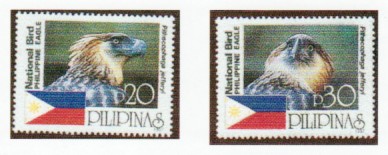
With
the increase in postage rates including parcel posts and express
mail service since 1996, there has long been a need to issue
definitives higher in values than P10, as most heavy parcels
and express mail pieces need hundreds of pesos in postage.
Although many mailers just use postage meters for these, there
are still those who prefer stamps. So multiples of the highest
value, P10, was needed and obviously, there was a lot of wastage
in stamp printing costs. Curiously, most custodians and tellers
object to high face value stamps because of the fear that any
mistake will cost them a lot, and many postal patrons are afraid
that chances of high value stamps being stolen before the mail
matter is dispatched is higher too, as temptation will be
greater. However, after some serious discussion, it was decided
that high values of P20, P30 and P50 should be added to the
national symbols definitives series. To discourage forgeries,
these high values will be printed in commemorative size. To
publicize the new national bird, all 3 stamps were to feature
the Philippine Eagle. Slides were provided by the Protected
Areas and Wildlife Bureau (PAWB), but it still took several
weeks for the designers and printer to come out with the stamps.
Only the P20 and P30 were finally issued on December 24, 1997.
The P50 was delayed because at the last minute, the design was
changed to another picture provided by a photographer from
Davao.
Starting with these 3 Eagle high values, all new
commemorative-sized stamps have the latest phosphorescent
security marking. This is printed all over the sheet, including
the sheet margins, and consists of "Philpost" with its logo
above it and a line identical to the blue security band below
it. These are arranged close together, in lines, in 4
orientations: upright, inverted, sideways and sideways inverted.
The ones printed sideways do not have the line below Philpost.
500,000 of each denomination were ordered, but there were
additional renegotiable quantities, so the final totals came to:
P20
--------------- 518,750
P30
--------------- 523,750
PART
XVI (P50 high value in commemorative size, with new overall
phosphor; scheduled for December 10, 1997 issuance)
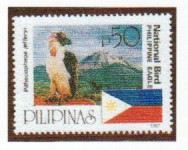
This
is the highest denomination of all Philippine postage stamps to
date. As mentioned earlier, this was supposed to come out
together with the other 2 high values, but due to a last-minute
change of design, it was postponed to December 10, 1997.
However, since the printer took a Christmas break after delivery
of the other 2 high values on December 24, 1997, this P50 stamp
was not issued until January 13, 1998!
There
were also 500,000 ordered, but with the additional renegotiated
quantity, it became 530,000.
PART XVII (se-tenant block of 14 x P4 dated "1996"; with gold
Philippine Centennial Commission logo overprint, issued on
June
12, 1998)
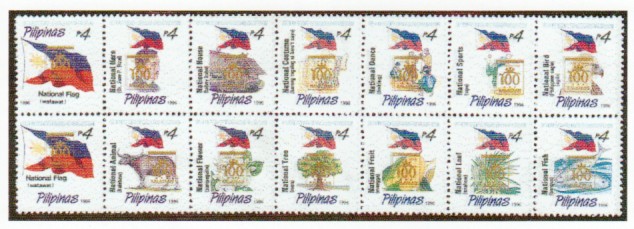
After the P4
se-tenant national symbols were withdrawn and invalidated in 1997
upon discovery of alleged forgeries of several designs, they were
recalled and over 20,000,000 were returned to the vaults.
With
the approach of the Philippine Independence Centennial on June
12, 1998, a perfect occasion to make use of these stamps
presented itself. By overprinting them with the National
Centennial Commission logo, Philpost can also help publicize the
centennial of our independence, a significant milestone in our
history. The additional overprint should discourage people who
may have produced or are holding any forgeries, if indeed there
really are such, from trying to use those forgeries again.
Several colors were tried, but gold was finally chosen, as it
will not mess up the original designs as much as other colors.
The special gold ink is relatively more difficult and expensive
to print also, which should make the criminal less inclined to
produce fake overprints, too! The logos were intentionally
printed on different positions on the stamps in the block to
avoid covering too much of the main design.
These
stamps were retrieved from the vaults and sent to Amstar for
overprinting in 3 batches. The first batch was sent on June 3,
1998 and totaled 15,000,000. Out of this, 100,000 were spoiled
during overprinting and later destroyed. The second batch, sent
on July 1, consisted of 2,700,000 pieces but 163,000 were
spoiled. The third and last batch, sent on October 2, totaled
3,156,400 pieces and out of this, 153,000 were spoiled.
A
total of 20,440,000 pieces in 102,202 good sheets of 200 were
therefore delivered and sold. Only 1,022,020 complete blocks of
14 exist, with half being Type A and the other half Type B.
Only
the sheets dated "1996" were supposed to be overprinted, but
somehow, 15 used copies dated "1995" were found. Out of these,
there were 11 different designs, with only the 2 Flags and the
Rizal stamp unaccounted for. No mint copies were ever found.

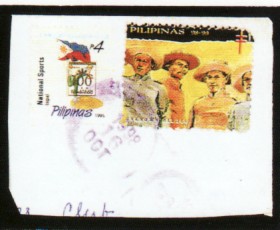
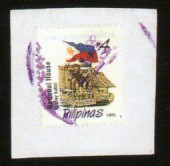 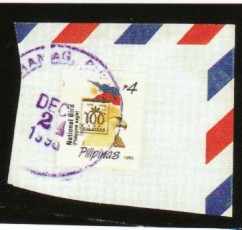
PART XVIIl (P3 Kalabaw head dated "1995" with gold Philippine
Centennial Commission logo overprint; issued on July 7, 1998)
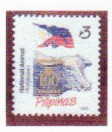
"Kalabaw" (Carabao) Head
This
overprinted stamp was supposea to oe put on sale together with
the overprinted se-tenant block, but the printer said they could
not cope, so this was postponed.
Although all the P3 Kalabaw head definitives, including those
dated "1993", "1994" and "1995" were withdrawn in 1995 upon
discovery of alleged forgeries, only the "1995" dated ones were
sent for overprinting. Whether any of the "1993" and "1994"
dated ones were mistakenly included remains to be seen.
Just
like the P4 se-tenant block, this stamp was sent to Amstar in 3
batches. The fast batch of 14,000,000 was sent to Amstar for
overprinting on June 18, 1998. Out of these, 140,000 were
spoiled. The second batch of 3,220,000 was sent on July 1, and
60,000 were spoiled. The third and last batch of 1,606,600 was
sent on October 2 and 38,400 were spoiled. Therefore, a total of
18,588,200 of this overprinted stamp exist.
FOR
SINGLE AND USED STAMPS COLLECTORS
I
have covered the entire series of 18 parts for this Philippine
flag with national symbols defmitives chronologically, and it
should now be easy for collectors of mint stamps to follow and
to identify their stamps. However, some collectors prefer used
stamps, so it is expected that singles from the souvenir sheet
and the se-tenant blocks will be encountered. To make it easier
for everyone to identify any national symbol definitive he may
have, another article listing the stamps by national symbols
will be very helpful.
There
are 14 national symbols depicted on 151 different single stamps.
Most of these symbols were issued with 3-4 different
denominations. Therefore, a list with illustrations of every
single stamp with a particular national symbol and a detailed
description of the changes made in subsequent printings will
enable everyone to identify any national symbol definitive he
may come across much more quickly.
In
the next article, I will also cover the "SPECIMEN" stamps
printed for several of these definitives. I will list the
various errors, freaks and oddities (EFO's) recorded for these
issues, too.
|
HOMEPAGE
|